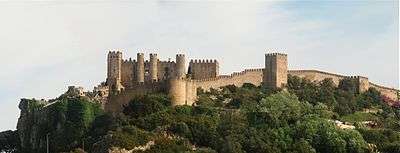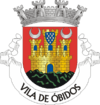Óbidos, Portugal
| Óbidos | |||
|---|---|---|---|
| Municipality | |||
|
A view of Óbidos | |||
| |||
 | |||
| Coordinates: 39°21′29″N 9°9′28″W / 39.35806°N 9.15778°WCoordinates: 39°21′29″N 9°9′28″W / 39.35806°N 9.15778°W | |||
| Country |
| ||
| Region | Centro | ||
| Subregion | Oeste | ||
| Intermunic. comm. | Oeste | ||
| District | Leiria | ||
| Parishes | 7 | ||
| Government | |||
| • President | Telmo Henrique Correia Daniel Faria (PPD-PSD) | ||
| Area | |||
| • Total | 141.55 km2 (54.65 sq mi) | ||
| Elevation | 49 m (161 ft) | ||
| Highest elevation | 221 m (725 ft) | ||
| Lowest elevation | 0 m (0 ft) | ||
| Population (2011) | |||
| • Total | 11,772 | ||
| • Density | 83/km2 (220/sq mi) | ||
| Time zone | WET/WEST (UTC+0/+1) | ||
| Postal code | 2510 | ||
| Area code | 295 | ||
| Patron | Santa Maria | ||
| Website |
www | ||
Óbidos (Portuguese pronunciation: [ˈɔβiðuʃ]) is a town (Portuguese: vila) and a municipality in the Oeste Subregion in Portugal. The town proper has approximately 3100 inhabitants. The municipality population in 2011 was 11,772,[1] in an area of 141.55 square kilometres (54.65 square miles).[2]
History

The name "Óbidos" probably derives from the Latin term oppidum, meaning "citadel", or "fortified city". The municipality had its origin in an early Roman settlement near the foothills of an elevated escarpment. The region of Óbidos, extending from the Atlantic to the interior of Estremadura Province along the rivers and lakes has been inhabited since the late Paleolithic.[3] A settlement was constructed by early Celt tribes, that was later a centre of trade for the Phoenicians.[3] Archeological evidence from the base of the medieval tower (south of Facho) at Óbidos Castle indicates Roman construction linked to an outpost of the Roman civitas of Eburobrittium, a large urban area that has been under excavation.[3] Archeological surveys determined the remains of a forum, baths and other Roman structures near the settlement.
After the fall of Rome, the region came under the influence of the Visigoths, although specific records are missing. The Roman town of Eburobrittium was abandoned in the 5th century for the more secure hilltop where today the principal settlement is located. Sometime after 713 the Moors established a fortification on this mountain, while a Christian community of Mozarabs lived in the Moncharro neighbourhood.
The area was taken from the Moors by the first King of Portugal, Afonso Henriques, in 1148. Tradition states that one knight, Gonçalo Mendes da Maia, was responsible for the successful storming of the Moorish castle.[3] The retaking of Óbidos was a final stage in the conquest of the Estremadura region, after the settlements of Santarém, Lisbon and Torres Vedras. Following the control of the region, the settlement received its first foral (English: charter) in 1195, during the reign of King Sancho I. In 1210, King Afonso II gave the title of this village to Queen Urraca. Since then, Óbidos has often been patronized by the Queens of Portugal, giving rise to its informal title as Vila das Rainhas (English: town of the Queens); several royal consorts enriched the village with donations from the Middle Ages until the 16th century.[3]
The castle and walls of Óbidos were remodelled during the reign of King Dinis I.[3] The limestone and marble structure was strengthened and elaborated, while the keep was created in the 14th century, by King Fernando. By the time of the first remodelling project, the settlement had also grown beyond the gates of the castle.
The Church of Santa Maria in Óbidos was the setting for the wedding of King Afonso V to his cousin, Princess Isabella of Coimbra, on 15 August 1441, when they were both still children aged 9 and 10, respectively.[3] Administrative reforms conducted by King Manuel I at Óbidos in 1513, included the institution of a formal charter and major requalification of the urban area.[3]
The 1755 earthquake caused damage to the village walls, a few churches, and many buildings, and resulted in the loss of architecture of Arab or Medieval inspiration.[3] Similarly, the Peninsular Wars were fought in the vicinity of Óbidos, including the Battle of Roliça.[3] More recently, the village was a centre of government and meeting place for those involved in the 1974 Carnation Revolution, linking it to the armed forces movement revolt.[3]
Geography

Located on the Atlantic Ocean coast, the municipality is bounded in the northeast and east by Caldas da Rainha, in the south by Bombarral, in the southeast by Lourinhã and in the west by Peniche. Administratively, it is divided into 7 civil parishes (freguesias):[4]
- A dos Negros
- Amoreira
- Gaeiras
- Olho Marinho
- Santa Maria, São Pedro e Sobral da Lagoa
- Usseira
- Vau
Tourism
The area of the town of Óbidos is located on a hilltop, encircled by a fortified wall. Óbidos remains a well-preserved example of medieval architecture; its streets, squares, walls and its castle are a popular tourist destination. The castle now houses a pousada. The municipality is also home to the famous Praia D'el Rey golf complex, one of the top golf resorts in Europe, and Royal Óbidos - Spa & Golf Resort.
Óbidos Medieval Market
Each July Óbidos castle hosts a traditional 'Medieval Market'. For two weeks the castle and the surrounding town recreate the spirit of medieval Europe.
Flowing banners and heraldic flags set the mood together with hundreds of entertainers and stall holders dressed as merchants, jugglers, jesters, wandering minstrels, soldiers and more. Visitors can shop at the traditional handcrafts fair or watch medieval shows, horse displays and a costumed parade that winds its way through the streets. There are also displays of jousting knights and armed combat.
Spit roasted hog, hearty soups, rabbit, lamb, cod, quail, sausages and other grilled meats are just some of the many medieval style meals on offer from dozens of "taverns" and stalls spread throughout the market. Drinking from pewter tankards and eating from wooden trencher all adds to the experience.
See also
References
- ↑ Instituto Nacional de Estatística
- ↑ Direção-Geral do Território
- 1 2 3 4 5 6 7 8 9 10 11 Óbidos Patrimonium (ed.). "Resumo Histórico" (in Portuguese). Óbidos, Portugal: Câmara Municipal de Óbidos.
- ↑ Diário da República. "Law nr. 11-A/2013, page 552 81" (pdf) (in Portuguese). Retrieved 29 July 2014.
External links
| Wikivoyage has a travel guide for Óbidos. |
| Wikimedia Commons has media related to Óbidos. |
- Óbidos Turismo, Município de Óbidos - Official Óbidos Tourism website (Portuguese) (English) (French)
- Obidos Guide
- The International Festival of Chocolate, Óbidos, Portugal - Official website (Portuguese) with basic information (dates, times, ticket prices) clearly shown.
- GoObidos - Oficial Obidos turistic Guide (Portugal) - Official Obidos Tourist Guide.
- Obidos turistic Guide (Portugal) - Website published in collaboration with Turismo de Portugal and Estoril Tourism School.


